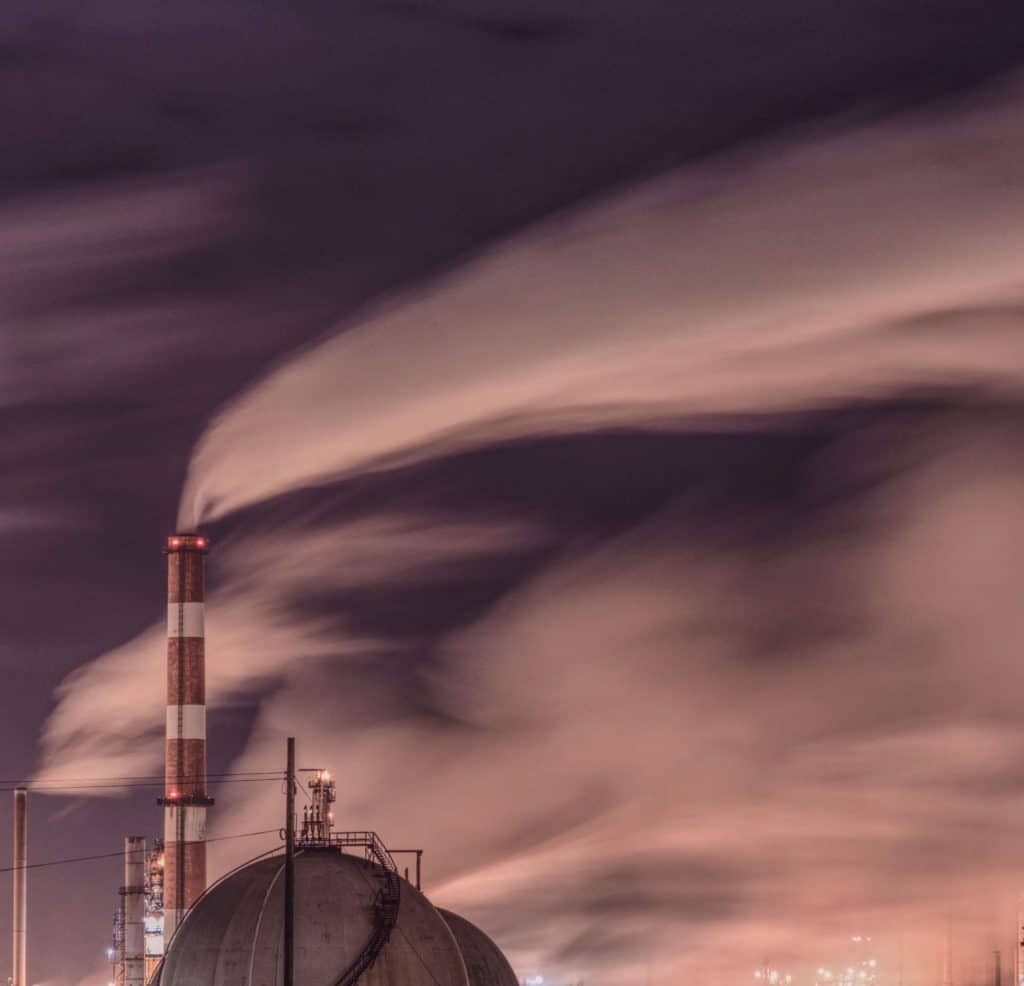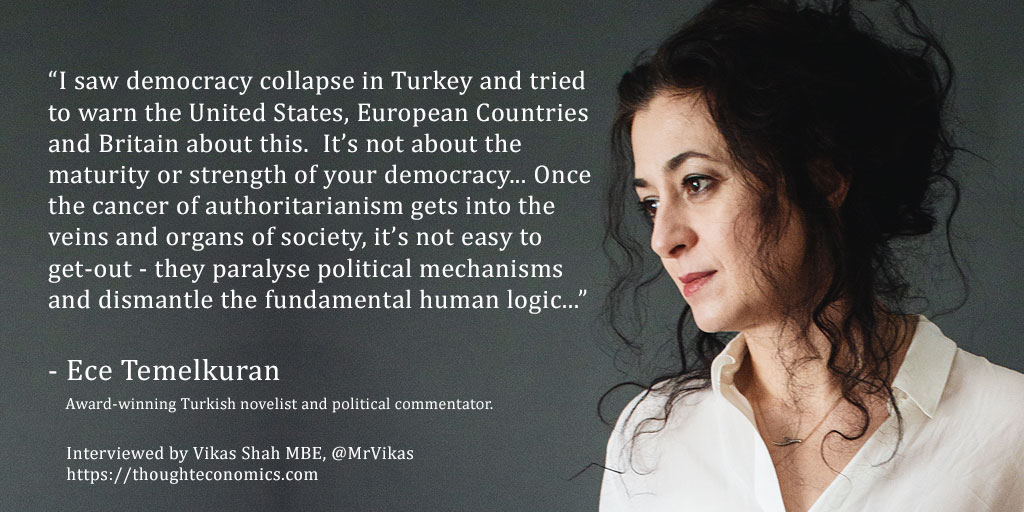
Fossil fuel companies claim they’re helping fight climate change. The reality is different.
By Kathy Mulvey, Myles Allen, Peter C. Frumhoff, December 17, 2019

Image courtesy VanveenJF/Unsplash
Imagine Rip Van Winkle as a climate-conscious investor. If Rip had fallen asleep after the Paris climate agreement was drafted in 2015 and woken up today, he might conclude that the fossil fuel industry is rapidly transforming itself to prepare for a carbon-constrained world. ExxonMobil TV ads tout its investments in algal biofuels, Chevron offers electric car charging at gas stations, BP spots on National Public Radio boast of turning garbage into fuel, Shell has acquired a British utility company that now sells only electricity from renewable sources, and the American Petroleum Institute claims to be leading the world in cutting greenhouse gases. Big Oil also helped design a proposal it could get behind to establish a carbon price in the United States: BP, ExxonMobil, and Shell pledged $1 million each in support of the Climate Leadership Council’s “carbon fee and dividend” proposal, and ConocoPhillips pledged $2 million. If Rip were influential in Washington, he would be barraged with digital ads for the Climate Leadership Council’s plan.
But Rip would also be confronted with troubling news of heat waves, drought, flooding, and wildfires, all of whose increased frequency and severity is attributable to climate change. He would learn that a Special Report of the Intergovernmental Panel on Climate Change concluded that what it termed “rapid and far-reaching” transitions would need to be made across major sectors of the global economy if we are going to keep global warming to 1.5 degrees Celsius above pre-industrial levels, the target set at the Paris Agreement. Climate science tells us that carbon dioxide emissions must reach what is called “net-zero” (no more carbon dioxide being released to the atmosphere than is actively withdrawn from it) for temperatures to stabilize at any level, which means that we must reach net-zero by roughly mid-century to stabilize at 1.5 degrees Celsius.
And, most alarmingly, he would learn that behind the fossil fuel companies’ climate charm offensive, they are betting that global temperatures will rise well above the Paris Agreement targets. For example, in ExxonMobil’s 2019 Outlook for Energy, the company projects no reductions in carbon dioxide emissions from the energy sector through 2040—and no date at which emissions reach net zero, implying indefinite warming. And ExxonMobil is not alone: Only 13 percent of the energy companies that follow the disclosure framework recommended by the Task Force on Climate-related Financial Disclosures are even testing the resilience of their business strategies in a scenario where global warming is kept below 2 degrees. A Transition Pathway Initiative survey of 50 oil and gas companies conducted earlier this year found that only one company (the Italian multinational oil and gas giant Eni) had made a public commitment to reduce its emissions to net zero by any date—and Eni’s commitment covers only the modest direct emissions from the extraction, processing, and refining of its fossil fuel products, not the much larger emissions that result from the burning of those products.
One of the few exceptions to this alarming state of affairs came earlier this month, when the Spanish energy multinational Repsol broke from the oil and gas industry pack by pledging to achieve net zero emissions from its operations and the use of its products by 2050—with intermediate decarbonization targets in place for 2020 to 2040. Repsol has thrown down the gauntlet to its competitors, putting into stark relief the yawning gap between their climate claims and actions. Repsol’s announcement should awaken Rip and other climate-conscious investors to reality: Until now, none of these companies has been doing nearly enough, fast enough, to align their business models with the Paris Agreement that they claim to support. As the shareholder advocacy group As You Sow concluded: “The fact that global greenhouse gas emissions, and oil and gas company capital expenditures on exploration and production, keep rising signals a fundamental limitation of the current shareholder engagement strategy.”
So, how should Rip and other climate-conscious investors focus their efforts as the remaining carbon budget dwindles?
Let’s start by taking a look at climate change, corporate accountability, and the roles of fossil fuel companies and shareholder advocacy, back in the heady days of the adoption of the Paris Agreement—and again today.
What a difference four years has not made. On the whole, the nations of the world have not followed through on the ambitions surrounding the signing of the Paris agreement in 2015. Add to that the mounting urgency of the climate crisis, and the Trump administration’s decision to withdraw from the agreement, and one can see why greater attention is being focused on actions by cities, states, and corporations. National governments aren’t the only ones making decisions that will determine whether the world achieves the Paris goals.
Among corporations, major fossil fuel producers have the most influence over our collective success or failure in avoiding the worst effects of climate change. Many major oil and gas companies make the claim that they support the Paris Agreement.
But how far are the emissions cuts promised by the major oil and gas companies from reaching a point consistent with the Paris Agreement goals? And how does the advocacy of their industry groups undermine or even contradict these companies’ stated declarations to the public? (The American Petroleum Institute, for example, has been going all-out in its efforts to gut a federal rule about the emission of methane, a potent greenhouse gas).
Shareholder proposals for 2020. Now that this year’s UN climate conference in Madrid is finished, shareholders in US-based oil and gas companies are turning their attention to 2020. Shareholder resolutions must be filed by mid-December of 2019 for consideration at the 2020 annual general meetings of ExxonMobil and Chevron. While most are not binding on company decision-makers even if they win a majority vote, shareholder resolutions have become a cornerstone of investor strategies to engage with major oil and gas companies over climate change, lobbying, and political spending issues.
For example, the current trend in climate risk reporting began after a decisive vote by ExxonMobil shareholders in favor of a 2017 resolution that called on the company to report annually on what climate change policies (set by governments) and technological advances (in the marketplace) designed to keep the global temperature increase below 2 degrees Celsius would have on the company’s business. This year, the Climate Action 100+ initiative, backed by 370 investors with more than $35 trillion in combined assets, secured an agreement from BP to support a shareholder resolution requesting the company to set out a strategy consistent with the Paris Agreement. With BP’s board supporting the resolution, 99 percent of shareholders voted for it: Unfortunately, neither the company nor its shareholders seem to appreciate—or at least are willing to acknowledge in public—that such a strategy must include a credible plan for achieving net zero emissions. In other words, the company and its shareholders approved the resolution without (apparently) accepting its necessary implications.
Regrettably, the success of public pension funds, faith groups, and other socially responsible investors in using shareholder resolutions to force publicly traded companies to plan for climate change has provoked a backlash. And that backlash has provided fuel to a long-simmering effort to quash shareholder democracy. The US Securities and Exchange Commission has just announced a new rule that would make it much harder for shareholders to file proposals on climate change and other environmental, social, and governance issues with publicly traded US companies.
Curtailing shareholder rights has long been on the wish list of industry groups such as the Business Roundtable, the National Association of Manufacturers, and the US Chamber of Commerce, which pushed for the rule change with a well-funded disinformation campaign. The National Association of Manufacturers—which includes BP, ConocoPhillips, ExxonMobil, Shell, and Chevron among its members—houses the misleadingly named Main Street Investors Coalition, which leads the lobbying campaign for this SEC rule change. The Sierra Club is suing the SEC for information about Big Oil’s involvement in its decision-making process on climate-related shareholder proposals.
Principles and practices for climate-conscious investment in fossil fuels. The Oxford Martin Principles provide a scientific framework for engagement between climate-conscious investors and companies across the global economy. Drafted in 2018 at the Oxford Martin School at the University of Oxford, UK, these principles build upon the science of long-term climate change, focusing on how investments contribute to the global stock of cumulative carbon dioxide emissions. They complement other measures, such as carbon footprinting. These principles are premised upon two cold, hard, scientific facts: First, net emissions of carbon dioxide must fall to zero for temperatures to stabilize at any level. And second, for temperatures to stabilize at about 1.5 degrees Celsius above pre-industrial levels, we must reach net zero carbon dioxide emissions roughly by mid-century—as well as make deep reductions in other heat-trapping gases, such as methane.
With these goals in mind, a climate-minded investor should look for companies to commit to net-zero emissions by a specific date, outline a business model consistent with that target, and establish quantitative mid-term milestones that allow users to assess progress. To boil things down further: Fossil fuel companies must commit to achieving net zero absolute carbon dioxide emissions by midcentury—and conduct all activities in ways that are verifiably consistent with this commitment.
To meet this core task, three methods of measuring progress, or metrics, are needed. They include disclosure of absolute emissions of carbon dioxide and other heat-trapping gases from company operations and the use of company products until carbon emissions reach net-zero; disclosure of mid-term targets; and consistent, verifiable actions that support fair and effective climate policies—including the accurate portrayal of climate science in all communications.
Let’s look at each of these metrics, one-by-one.
Disclosure of absolute emissions and emissions intensities. Companies must disclose the absolute emissions of heat-trapping gases from the use of company products as well as from the company’s extraction, refining, processing, and transportation of fossil fuels. The commitment to net-zero emissions by midcentury must encompass not only emissions from company operations but also emissions from the end-use of their products as well. Many fossil fuel companies have begun to set targets for reducing global warming emissions from their business operations—in other words, the greenhouse gases emitted from exploring for, extracting, processing, and bringing fossil fuels to market. But reporting on just this side of the ledger is not enough: Roughly 80-to-90 percent of fossil fuel companies’ carbon emissions result from end-users burning fossil fuel products.
(And we should take a moment here to note that fossil fuel companies have been attempting to shift the blame, by branding end-use emissions as “customer emissions”—as if to wash their hands of their product once it’s sold. But like consumers of tobacco products, consumers of fossil fuels use them exactly as the manufacturer intends them to be used.)
Major oil and gas companies take a variety of positions when it comes to their sense of responsibility for the emissions resulting from the use of their products. Repsol’s net zero target includes all product-related emissions, and Shell has set modest emissions-intensity reduction targets encompassing the use of its products. But BP and Chevron, meanwhile,reject the very notion that they bear any responsibility for these emissions.
Why is it justifiable to hold fossil fuel companies, instead of their customers, primarily responsible for bringing emissions from their products to net zero? The answer is threefold.
First, the products that they extracted and put into commerce are contributing the majority of global industrial carbon dioxide emissions driving disruptive climate change. This implies what ethical philosopher Henry Shue calls a “general, forward-looking responsibility to ‘do no harm.’”
Second, it didn’t have to be this way. Research shows that major fossil fuel companies knew at least 50 years ago that unabated burning of their products would change the Earth’s climate. And nearly 40 years ago, internal corporate and industry discussions identified alternatives to simply dumping carbon dioxide into the atmosphere, including carbon capture and storage—but these companies failed to adapt their business plans.
And third, the fossil fuel companies have a well-documented history of involvement with spreading climate disinformation and seeking to block climate action, as exemplified by a 1998 internal memo written by a team convened by the American Petroleum Institute. Major fossil fuel companies consequently have what Shue terms a “special, backward-looking causal responsibility to ‘clean up your own mess.’ ”
Disclosure of mid-term targets for implementing and investing toward net-zero. If investors are going to assess the climate plans of companies, then it is absolutely necessary for companies to disclose their mid-term targets for reducing their carbon emissions. Consequently, shareholders should require that companies set, publish, and report on progress toward targets for reducing both the companies’ absolute emissions and their emissions intensity (carbon dioxide emissions per unit of production). Otherwise, it’s too easy for companies to game the system. For instance, while increasing the volume of its oil and gas production, a company could achieve a modest emissions intensity reduction target by making its operations and its products less carbon-intensive: A somewhat larger amount of carbon dioxide emitted into the atmosphere divided by a much larger volume of oil and gas produced would result in a lower emissions intensity. Conversely, a company could reduce its absolute emissions through spinoffs and restructuring that would make it difficult to trace emissions back to the ultimate corporate owner of the polluting assets. That is why investors need to track both absolute and intensity metrics: Neither system of measurement stands alone.
For example, while Shell says its ambition is to reduce the global warming emissions from its operations, energy usage, and use of its products by 50 percent by 2050, Shell also plans to spend $30 billion per year during the period of 2021-to-2025 on average investments in oil and gas infrastructure and exploration. Crucially, Shell cites no plans for any accompanying equivalent investment in carbon capture and storage, the only option available for the large-scale disposal of carbon dioxide other than dumping it into the atmosphere. (As is typical of the industry as a whole, Shell’s investment in carbon capture technology is dwarfed by its investment in exploration for new fossil fuel resources.) There is enough fossil carbon stored in existing fossil fuel reserves to take the world well beyond 2 degrees Celsius. So, to comply with the Paris Agreement, companies would need to dramatically redirect their investments. For every metric ton of fossil carbon identified in a new oil or gas field, the industry must, at a minimum, identify options for the permanent geological storage for 3.7 metric tons of carbon dioxide—and invest to ensure that storage capacity is available on time. This will likely entail a dramatic redirection of investment away from exploring for new fossil fuel resources towards carbon dioxide capture and disposal. If fossil fuel companies aren’t doing so—and they aren’t even remotely close—then they are planning on letting their products take the world past two degrees.
It really is that simple.
Suggestions that any more than a modest fraction of this fossil carbon could be mopped up by forests, soils, and mangroves just don’t add up.
Consistent, verifiable actions that support fair and effective climate policies. The third reason that it is essential to hold fossil fuel companies responsible for bringing emissions from their products to net zero lies in the companies’ past and ongoing conduct. Even as some fossil fuel companies have begun to acknowledge climate change and claim to support climate policy, many still do not back up their words with consistent action. In other words, fossil fuel companies have a habit of saying one thing while doing another.
Misrepresentation of climate science and climate risks is getting fossil fuel companies into legal trouble, drawing parallels with the litigation against the tobacco and pharmaceutical industries. ExxonMobil, for example, was recently sued by the Massachusetts attorney general for misleading investors and engaging in deceptive advertising to consumers—including “greenwashing” campaigns that portray the company as a clean energy innovator. The environmental law organization Client Earth has filed a complaint against BP, saying that the fossil fuel company’s global ad campaign is misleading consumers by falsely claiming that the company is focused on renewable energy and climate solutions.
Given the fossil fuel industry’s history of deception, disinformation, and intimidation, the burden of proof rests on these companies to dispel skepticism. Instead, many continue to earn distrust. For example, the oil industry—led by Climate Leadership Council founding member BP and other companies that claim to support a price on carbon—bankrolled the successful campaign against a proposed carbon fee in Washington state in 2018. Investors must insist that a fossil fuel company making a net-zero commitment back it up with consistent, verifiable actions, including accurately representing climate science in its communications, supporting fair and effective climate policies, ensuring that its lobbying matches its stated positions on climate science and policy, and publicly disavowing positions and actions taken by affiliated third parties that are inconsistent with company positions.
The pressure on them to do so is mounting. In September, 200 institutional investors with a combined total of more than $6.5 trillion in assets urged publicly traded US corporations to align their climate lobbying with the goals of the Paris Agreement. Nongovernmental organizations that engage with business on environmental issues followed with an open letter in The New York Times setting new standards for corporate leadership on science-based climate policy.
Guidance for corporate engagement and investment decisions. These recommendations—along with those of the Climate Action 100+ initiative, which has secured emissions-reduction commitments from companies including BP, Equinor, and Shell—should elevate the issue of climate policy alignment. But short-term, incremental reductions are not enough. These companies are among the few today that are actively investing in plants and equipment that will define the world in 2050. Investors have a right to know how these investments square with net-zero emissions.
If we want to avert disruptive climate change, we must not only reduce emissions, we must fully decarbonize our economy. And decarbonization has a hard and fast deadline. The principles and practices outlined here should also be applied to escalate pressure on laggard companies. (For example, with no-confidence votes in corporate leadership targeting particular board members or the entire board.) They should be used to challenge a company’s refusals to consider shareholder proposals about reaching net zero—including, if necessary, through the courts. And these principles and practices must be used to determine when to give up on an engagement that’s securing only incremental changes, and decide when it is time to divest entirely. Institutions such as Barnard College, the San Francisco Employees’ Retirement System, the Church of England, and Legal & General Investment Management are now divesting in ways that differentiate among fossil fuel producers, in order to provide a financial incentive to companies to accelerate their climate actions.
The Madrid climate conference has reminded us of the urgency of climate action by all sectors of society. 2020 will be a pivotal year for shareholders seeking to hold major fossil fuel companies accountable to the science of meeting the Paris Agreement targets. We urge investors to take up the Oxford Martin principles and expect more, question more, and tolerate less from the fossil fuel companies. These major contributors to global warming must swiftly get on board with climate action—or get out of the way.
Imagine Rip Van Winkle as a climate-conscious investor. If Rip had fallen asleep after the Paris climate agreement was drafted in 2015 and woken up today, he might conclude that the fossil fuel industry is rapidly transforming itself to prepare for a carbon-constrained world. ExxonMobil TV ads tout its investments in algal biofuels, Chevron offers electric car charging at gas stations, BP spots on National Public Radio boast of turning garbage into fuel, Shell has acquired a British utility company that now sells only electricity from renewable sources, and the American Petroleum Institute claims to be leading the world in cutting greenhouse gases. Big Oil also helped design a proposal it could get behind to establish a carbon price in the United States: BP, ExxonMobil, and Shell pledged $1 million each in support of the Climate Leadership Council’s “carbon fee and dividend” proposal, and ConocoPhillips pledged $2 million. If Rip were influential in Washington, he would be barraged with digital ads for the Climate Leadership Council’s plan.
But Rip would also be confronted with troubling news of heat waves, drought, flooding, and wildfires, all of whose increased frequency and severity is attributable to climate change. He would learn that a Special Report of the Intergovernmental Panel on Climate Change concluded that what it termed “rapid and far-reaching” transitions would need to be made across major sectors of the global economy if we are going to keep global warming to 1.5 degrees Celsius above pre-industrial levels, the target set at the Paris Agreement. Climate science tells us that carbon dioxide emissions must reach what is called “net-zero” (no more carbon dioxide being released to the atmosphere than is actively withdrawn from it) for temperatures to stabilize at any level, which means that we must reach net-zero by roughly mid-century to stabilize at 1.5 degrees Celsius.
And, most alarmingly, he would learn that behind the fossil fuel companies’ climate charm offensive, they are betting that global temperatures will rise well above the Paris Agreement targets. For example, in ExxonMobil’s 2019 Outlook for Energy, the company projects no reductions in carbon dioxide emissions from the energy sector through 2040—and no date at which emissions reach net zero, implying indefinite warming. And ExxonMobil is not alone: Only 13 percent of the energy companies that follow the disclosure framework recommended by the Task Force on Climate-related Financial Disclosures are even testing the resilience of their business strategies in a scenario where global warming is kept below 2 degrees. A Transition Pathway Initiative survey of 50 oil and gas companies conducted earlier this year found that only one company (the Italian multinational oil and gas giant Eni) had made a public commitment to reduce its emissions to net zero by any date—and Eni’s commitment covers only the modest direct emissions from the extraction, processing, and refining of its fossil fuel products, not the much larger emissions that result from the burning of those products.
One of the few exceptions to this alarming state of affairs came earlier this month, when the Spanish energy multinational Repsol broke from the oil and gas industry pack by pledging to achieve net zero emissions from its operations and the use of its products by 2050—with intermediate decarbonization targets in place for 2020 to 2040. Repsol has thrown down the gauntlet to its competitors, putting into stark relief the yawning gap between their climate claims and actions. Repsol’s announcement should awaken Rip and other climate-conscious investors to reality: Until now, none of these companies has been doing nearly enough, fast enough, to align their business models with the Paris Agreement that they claim to support. As the shareholder advocacy group As You Sow concluded: “The fact that global greenhouse gas emissions, and oil and gas company capital expenditures on exploration and production, keep rising signals a fundamental limitation of the current shareholder engagement strategy.”
So, how should Rip and other climate-conscious investors focus their efforts as the remaining carbon budget dwindles?
Let’s start by taking a look at climate change, corporate accountability, and the roles of fossil fuel companies and shareholder advocacy, back in the heady days of the adoption of the Paris Agreement—and again today.
What a difference four years has not made. On the whole, the nations of the world have not followed through on the ambitions surrounding the signing of the Paris agreement in 2015. Add to that the mounting urgency of the climate crisis, and the Trump administration’s decision to withdraw from the agreement, and one can see why greater attention is being focused on actions by cities, states, and corporations. National governments aren’t the only ones making decisions that will determine whether the world achieves the Paris goals.
Among corporations, major fossil fuel producers have the most influence over our collective success or failure in avoiding the worst effects of climate change. Many major oil and gas companies make the claim that they support the Paris Agreement.
But how far are the emissions cuts promised by the major oil and gas companies from reaching a point consistent with the Paris Agreement goals? And how does the advocacy of their industry groups undermine or even contradict these companies’ stated declarations to the public? (The American Petroleum Institute, for example, has been going all-out in its efforts to gut a federal rule about the emission of methane, a potent greenhouse gas).
Shareholder proposals for 2020. Now that this year’s UN climate conference in Madrid is finished, shareholders in US-based oil and gas companies are turning their attention to 2020. Shareholder resolutions must be filed by mid-December of 2019 for consideration at the 2020 annual general meetings of ExxonMobil and Chevron. While most are not binding on company decision-makers even if they win a majority vote, shareholder resolutions have become a cornerstone of investor strategies to engage with major oil and gas companies over climate change, lobbying, and political spending issues.
For example, the current trend in climate risk reporting began after a decisive vote by ExxonMobil shareholders in favor of a 2017 resolution that called on the company to report annually on what climate change policies (set by governments) and technological advances (in the marketplace) designed to keep the global temperature increase below 2 degrees Celsius would have on the company’s business. This year, the Climate Action 100+ initiative, backed by 370 investors with more than $35 trillion in combined assets, secured an agreement from BP to support a shareholder resolution requesting the company to set out a strategy consistent with the Paris Agreement. With BP’s board supporting the resolution, 99 percent of shareholders voted for it: Unfortunately, neither the company nor its shareholders seem to appreciate—or at least are willing to acknowledge in public—that such a strategy must include a credible plan for achieving net zero emissions. In other words, the company and its shareholders approved the resolution without (apparently) accepting its necessary implications.
Regrettably, the success of public pension funds, faith groups, and other socially responsible investors in using shareholder resolutions to force publicly traded companies to plan for climate change has provoked a backlash. And that backlash has provided fuel to a long-simmering effort to quash shareholder democracy. The US Securities and Exchange Commission has just announced a new rule that would make it much harder for shareholders to file proposals on climate change and other environmental, social, and governance issues with publicly traded US companies.
Curtailing shareholder rights has long been on the wish list of industry groups such as the Business Roundtable, the National Association of Manufacturers, and the US Chamber of Commerce, which pushed for the rule change with a well-funded disinformation campaign. The National Association of Manufacturers—which includes BP, ConocoPhillips, ExxonMobil, Shell, and Chevron among its members—houses the misleadingly named Main Street Investors Coalition, which leads the lobbying campaign for this SEC rule change. The Sierra Club is suing the SEC for information about Big Oil’s involvement in its decision-making process on climate-related shareholder proposals.
Principles and practices for climate-conscious investment in fossil fuels. The Oxford Martin Principles provide a scientific framework for engagement between climate-conscious investors and companies across the global economy. Drafted in 2018 at the Oxford Martin School at the University of Oxford, UK, these principles build upon the science of long-term climate change, focusing on how investments contribute to the global stock of cumulative carbon dioxide emissions. They complement other measures, such as carbon footprinting. These principles are premised upon two cold, hard, scientific facts: First, net emissions of carbon dioxide must fall to zero for temperatures to stabilize at any level. And second, for temperatures to stabilize at about 1.5 degrees Celsius above pre-industrial levels, we must reach net zero carbon dioxide emissions roughly by mid-century—as well as make deep reductions in other heat-trapping gases, such as methane.
With these goals in mind, a climate-minded investor should look for companies to commit to net-zero emissions by a specific date, outline a business model consistent with that target, and establish quantitative mid-term milestones that allow users to assess progress. To boil things down further: Fossil fuel companies must commit to achieving net zero absolute carbon dioxide emissions by midcentury—and conduct all activities in ways that are verifiably consistent with this commitment.
To meet this core task, three methods of measuring progress, or metrics, are needed. They include disclosure of absolute emissions of carbon dioxide and other heat-trapping gases from company operations and the use of company products until carbon emissions reach net-zero; disclosure of mid-term targets; and consistent, verifiable actions that support fair and effective climate policies—including the accurate portrayal of climate science in all communications.
Let’s look at each of these metrics, one-by-one.
Disclosure of absolute emissions and emissions intensities. Companies must disclose the absolute emissions of heat-trapping gases from the use of company products as well as from the company’s extraction, refining, processing, and transportation of fossil fuels. The commitment to net-zero emissions by midcentury must encompass not only emissions from company operations but also emissions from the end-use of their products as well. Many fossil fuel companies have begun to set targets for reducing global warming emissions from their business operations—in other words, the greenhouse gases emitted from exploring for, extracting, processing, and bringing fossil fuels to market. But reporting on just this side of the ledger is not enough: Roughly 80-to-90 percent of fossil fuel companies’ carbon emissions result from end-users burning fossil fuel products.
(And we should take a moment here to note that fossil fuel companies have been attempting to shift the blame, by branding end-use emissions as “customer emissions”—as if to wash their hands of their product once it’s sold. But like consumers of tobacco products, consumers of fossil fuels use them exactly as the manufacturer intends them to be used.)
Major oil and gas companies take a variety of positions when it comes to their sense of responsibility for the emissions resulting from the use of their products. Repsol’s net zero target includes all product-related emissions, and Shell has set modest emissions-intensity reduction targets encompassing the use of its products. But BP and Chevron, meanwhile,reject the very notion that they bear any responsibility for these emissions.
Why is it justifiable to hold fossil fuel companies, instead of their customers, primarily responsible for bringing emissions from their products to net zero? The answer is threefold.
First, the products that they extracted and put into commerce are contributing the majority of global industrial carbon dioxide emissions driving disruptive climate change. This implies what ethical philosopher Henry Shue calls a “general, forward-looking responsibility to ‘do no harm.’”
Second, it didn’t have to be this way. Research shows that major fossil fuel companies knew at least 50 years ago that unabated burning of their products would change the Earth’s climate. And nearly 40 years ago, internal corporate and industry discussions identified alternatives to simply dumping carbon dioxide into the atmosphere, including carbon capture and storage—but these companies failed to adapt their business plans.
And third, the fossil fuel companies have a well-documented history of involvement with spreading climate disinformation and seeking to block climate action, as exemplified by a 1998 internal memo written by a team convened by the American Petroleum Institute. Major fossil fuel companies consequently have what Shue terms a “special, backward-looking causal responsibility to ‘clean up your own mess.’ ”
Disclosure of mid-term targets for implementing and investing toward net-zero. If investors are going to assess the climate plans of companies, then it is absolutely necessary for companies to disclose their mid-term targets for reducing their carbon emissions. Consequently, shareholders should require that companies set, publish, and report on progress toward targets for reducing both the companies’ absolute emissions and their emissions intensity (carbon dioxide emissions per unit of production). Otherwise, it’s too easy for companies to game the system. For instance, while increasing the volume of its oil and gas production, a company could achieve a modest emissions intensity reduction target by making its operations and its products less carbon-intensive: A somewhat larger amount of carbon dioxide emitted into the atmosphere divided by a much larger volume of oil and gas produced would result in a lower emissions intensity. Conversely, a company could reduce its absolute emissions through spinoffs and restructuring that would make it difficult to trace emissions back to the ultimate corporate owner of the polluting assets. That is why investors need to track both absolute and intensity metrics: Neither system of measurement stands alone.
For example, while Shell says its ambition is to reduce the global warming emissions from its operations, energy usage, and use of its products by 50 percent by 2050, Shell also plans to spend $30 billion per year during the period of 2021-to-2025 on average investments in oil and gas infrastructure and exploration. Crucially, Shell cites no plans for any accompanying equivalent investment in carbon capture and storage, the only option available for the large-scale disposal of carbon dioxide other than dumping it into the atmosphere. (As is typical of the industry as a whole, Shell’s investment in carbon capture technology is dwarfed by its investment in exploration for new fossil fuel resources.) There is enough fossil carbon stored in existing fossil fuel reserves to take the world well beyond 2 degrees Celsius. So, to comply with the Paris Agreement, companies would need to dramatically redirect their investments. For every metric ton of fossil carbon identified in a new oil or gas field, the industry must, at a minimum, identify options for the permanent geological storage for 3.7 metric tons of carbon dioxide—and invest to ensure that storage capacity is available on time. This will likely entail a dramatic redirection of investment away from exploring for new fossil fuel resources towards carbon dioxide capture and disposal. If fossil fuel companies aren’t doing so—and they aren’t even remotely close—then they are planning on letting their products take the world past two degrees.
It really is that simple.
Suggestions that any more than a modest fraction of this fossil carbon could be mopped up by forests, soils, and mangroves just don’t add up.
Consistent, verifiable actions that support fair and effective climate policies. The third reason that it is essential to hold fossil fuel companies responsible for bringing emissions from their products to net zero lies in the companies’ past and ongoing conduct. Even as some fossil fuel companies have begun to acknowledge climate change and claim to support climate policy, many still do not back up their words with consistent action. In other words, fossil fuel companies have a habit of saying one thing while doing another.
Misrepresentation of climate science and climate risks is getting fossil fuel companies into legal trouble, drawing parallels with the litigation against the tobacco and pharmaceutical industries. ExxonMobil, for example, was recently sued by the Massachusetts attorney general for misleading investors and engaging in deceptive advertising to consumers—including “greenwashing” campaigns that portray the company as a clean energy innovator. The environmental law organization Client Earth has filed a complaint against BP, saying that the fossil fuel company’s global ad campaign is misleading consumers by falsely claiming that the company is focused on renewable energy and climate solutions.
Given the fossil fuel industry’s history of deception, disinformation, and intimidation, the burden of proof rests on these companies to dispel skepticism. Instead, many continue to earn distrust. For example, the oil industry—led by Climate Leadership Council founding member BP and other companies that claim to support a price on carbon—bankrolled the successful campaign against a proposed carbon fee in Washington state in 2018. Investors must insist that a fossil fuel company making a net-zero commitment back it up with consistent, verifiable actions, including accurately representing climate science in its communications, supporting fair and effective climate policies, ensuring that its lobbying matches its stated positions on climate science and policy, and publicly disavowing positions and actions taken by affiliated third parties that are inconsistent with company positions.
The pressure on them to do so is mounting. In September, 200 institutional investors with a combined total of more than $6.5 trillion in assets urged publicly traded US corporations to align their climate lobbying with the goals of the Paris Agreement. Nongovernmental organizations that engage with business on environmental issues followed with an open letter in The New York Times setting new standards for corporate leadership on science-based climate policy.
Guidance for corporate engagement and investment decisions. These recommendations—along with those of the Climate Action 100+ initiative, which has secured emissions-reduction commitments from companies including BP, Equinor, and Shell—should elevate the issue of climate policy alignment. But short-term, incremental reductions are not enough. These companies are among the few today that are actively investing in plants and equipment that will define the world in 2050. Investors have a right to know how these investments square with net-zero emissions.
If we want to avert disruptive climate change, we must not only reduce emissions, we must fully decarbonize our economy. And decarbonization has a hard and fast deadline. The principles and practices outlined here should also be applied to escalate pressure on laggard companies. (For example, with no-confidence votes in corporate leadership targeting particular board members or the entire board.) They should be used to challenge a company’s refusals to consider shareholder proposals about reaching net zero—including, if necessary, through the courts. And these principles and practices must be used to determine when to give up on an engagement that’s securing only incremental changes, and decide when it is time to divest entirely. Institutions such as Barnard College, the San Francisco Employees’ Retirement System, the Church of England, and Legal & General Investment Management are now divesting in ways that differentiate among fossil fuel producers, in order to provide a financial incentive to companies to accelerate their climate actions.
The Madrid climate conference has reminded us of the urgency of climate action by all sectors of society. 2020 will be a pivotal year for shareholders seeking to hold major fossil fuel companies accountable to the science of meeting the Paris Agreement targets. We urge investors to take up the Oxford Martin principles and expect more, question more, and tolerate less from the fossil fuel companies. These major contributors to global warming must swiftly get on board with climate action—or get out of the way.
Kathy Mulvey
Kathy Mulvey is accountability campaign director in the Climate & Energy Program at the Union of Concerned Scientists, where she guides engagement with major fossil fuel companies, condu...
Myles Allen
Myles Allen is a professor of geosystem science at the Environmental Change Institute in the School of Geography and the Environment, and a professor the Department of Physics, both at the U...
Peter C. Frumhoff
Peter C. Frumhoff is the director of science and policy, and chief climate scientist at the Union of Concerned Scientists. An author of multiple Intergovernmental Panel on Climate Change rep...










